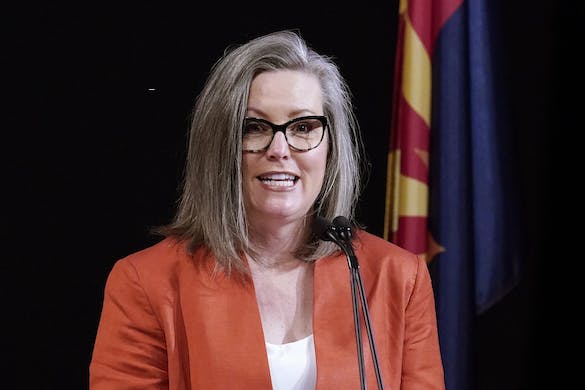Why Arizona Is Turning Blue
Analysts are wary of assigning too much significance to the state’s leftward shift but watch the other western states.

A convergence of factors including migration from blue states, growth of minority communities, and ideological shifts are making Democrats unexpected frontrunners in Arizona for the 2022 midterm elections. Similar factors could influence other elections across the West.
In the Arizona gubernatorial race, Secretary of State Katie Hobbs, a Democrat, is ahead of any potential Republican opponents in the polls. Most recently a Target Smart survey put Ms. Hobbs up by 9 points against Kari Lake and up 5 against Karrin Taylor Robinson.
It’s a newsworthy moment in the Grand Canyon State. Arizona voters supported every Republican presidential candidate between 1952 and 2016 except for when President Clinton defeated Senator Dole by two points in 1996. In 2020, President Biden carried the state by a razor-thin margin.
Despite the state’s conservative history and 2022 being touted as a “red-wave” year, it appears that Democrats are leading in Arizona once again, and this extends beyond just the gubernatorial race. In the Senate contest, the incumbent, Mark Kelly, is leading the Republican frontrunners, Jim Lamon and Blake Masters, by 6 points and 9 points respectively, according to Democratic polling.
Nonpartisan polling in May put Mr. Kelly even further ahead. A professor with Arizona State University, Brooks Simpson, argues that Arizona’s stalwart Republicanism is gone after having been undergoing changes since the 1990s. “The Arizona of the 1960s, 1970s, 1980s — of Goldwater Libertarianism — was challenged in the 1990s,” he tells the Sun.
Four emerging trends are largely responsible for Arizona’s shift into a swing state over the past 30 years and could take the state further to the left, according to the mayor of Tucson, Thomas Volgy, a professor of political science at University of Arizona.
“One has been the issue of continuous immigration to Arizona from other states — California, the West Coast, and the East Coast: Most people moving here are less conservative,” Mr. Volgy tells the Sun.
Mr. Simpson agrees with this observation, noting that migrants from New York, Illinois, and California are among the most common newcomers in the state, and they often arrive with political viewpoints that are different than those of residents.
A second trend Mr. Volgy identifies as key to understanding the shift is the growth in Arizona’s African American and Latino communities, both of which have tended to vote Democratic.
Mr. Volgy argues that the recent shift among Latinos toward Republicans, while significant, has been exaggerated and that the “Democratic coalition appears to be holding.”
Mr. Simpson agrees, arguing that the victory of Myra Flores in south Texas, while significant, has been given undue attention by political analysts.
“I think the significance of the Latino vote has been exaggerated,” Mr. Simpson says. “We always read too much into singular examples that are not demonstrative of the whole.”
A third phenomenon responsible for Democratic success in Arizona is the waning support for the GOP among voters with libertarian sensibilities.
“As the Republicans move further to the right, what they’ve experienced is substantial flight of Republicans to not become Democrats but to become independents,” Mr. Volgy says.
He points to issues like abortion, regarding which many Republicans advocate for government intervention into private life, as being alienating to libertarian voters.
Mr. Simpson also cites the growing rift between Arizona Republicans who are loyal to President Trump and those who would rather move on.
“With John McCain’s departure you really do have a fight for the heart of the Republican Party,” Mr. Simpson said. Senator Sinema, he reckons, “realizes if she takes a center position she can attract disaffected Republicans.”
The Republican shift rightward has combined with Arizona’s late August primary date to further hurt the Republicans in the state. Messers. Volgy and Simpson agree that it is challenging for Republicans to shift from successful primary messaging to messaging for the general election.
While Arizona is trending toward Democrats, the 2022 race and the overall fight for Arizona are far from over. With all the momentum Democrats have in Arizona, Mr. Simpson is reserved in predicting Democratic victory in November.
He points to significant headwinds they will face going toward Election Day. “Democrats should have realized that inheriting what they inherited was going to lead to a lot of challenging economic indicators,” Mr Simpson says.
These indicators and a challenging national economic environment could hurt Democrats at the polls, as voters associate the current economic crisis with the party in power. Mr. Simpson also argues that Democrats have historically bungled opportunities in Arizona.
More broadly, both analysts are wary of assigning too much national significance to Arizona’s blue shift, but, as Mr. Simpson puts it, they do see “echoes” of Arizona’s situation in other western states.
States like Nevada, New Mexico, and Texas have all been seeing influxes of residents from liberal states such as New York, California, and Illinois. Mr. Simpson, however, argues that the candidates will still be the biggest factor in who wins in November.
“We may really be in for a more hectic general election season if the Trump candidates prevail in the primaries,” he says. “The Democratic Party, when it has won, has chosen very centrist candidates.”

